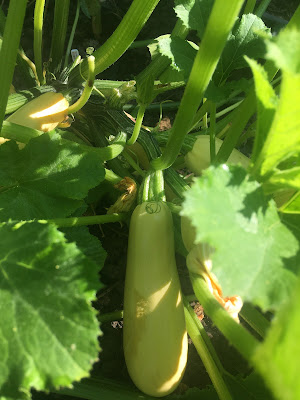July is hot in our valley - hotter than I enjoy. Luckily, most big projects have either been completed or deferred until next year, and the yard is blooming with lots of flowers. It's too late to plant most summer veggies, and too early to start fall crops, so my focus is on garden care - watering, weeding, mulching - and on HARVEST.
Agenda:
1. July harvest
2. July garden care
3. July planting tips
1. July Harvest:
All year, your most important task in the garden is to harvest AND USE what you’ve already grown. Harvest the low maintenance, high value crops first, and figure out how to use them in the kitchen. Just do what you can and enjoy it.
I'm picking summer squash, peas, and raspberries almost every day, and onions when I need them. I should also harvest beets and garlic soon.
Garlic is ready to harvest, when the bottom 3-4 leaves of the plant have died. Lift the bulbs gently with a digging fork, and cure it on a tray for 2 weeks in a warm, dry, well-ventilated area. Trim roots to 1/2-inch long and store bulbs in hanging wire baskets or mesh produce bags. Air circulation is essential. Also, use the garlic stems as mulch around pest-prone plants; pests are repelled by the garlic scent.
2. July garden care:
- Mulch and weed: In permaculture, weeds are considered an essential part of the ecosystem. I have stopped pulling weeds in some beds, and instead I tear them off at the ground and use them as mulch. This method leaves the soil untilled; tilling exposes new seeds, and you just get more weeds. But I still pull weeds that are close to my veggie plants.
- Broadleaf Plantain (Plantago major): Plantain often pops up where soil is compacted, and we had a bunch pop up last year after we re-organized our garden beds. Plantain is a nutrient accumulator, and benefits the soil if left to grow and die back on its own. Where I don't want to see plantain, I cut the leaves back monthly and use them as mulch, or give them to the ducks. If I leave the roots intact the plant will either regrow, or the roots will decay, enriching the soil and attracting beneficial soil organisms.
- Cucumber beetles and squash bugs: So far we haven't had as many squash bugs as we did last year, but we have had a bunch of cucumber beetles: They are striped yellow and black bugs that feed on leaves and stems, and a large infestation can defoliate plants. They also spread the deadly bacterial wilt disease.
I will continue to be diligent with removing squash beetles and bugs. I use a large tweezer to pick the bugs out of the squash flowers, and put them into a bucket of water.
Other tips to remember: Remove mulch because it offers shelter for squash bugs. Look for eggs on the underside of leaves and rub them off.
- Deadhead herbs and flowers often.
- Water thirsty plants such as raspberries if needed.
2. July planting tips:
The only summer plants that can still be planted outdoors from seed are bush beans (before mid-July) and beets (before the end of July).
July is also when to start some greens from seed to overwinter, such as kale, but they need to be started indoors where you can control the water and heat, then set them out later, when the temperature is consistently below 90º. (Start Pak choy and spinach a little later, in early August.)



No comments:
Post a Comment